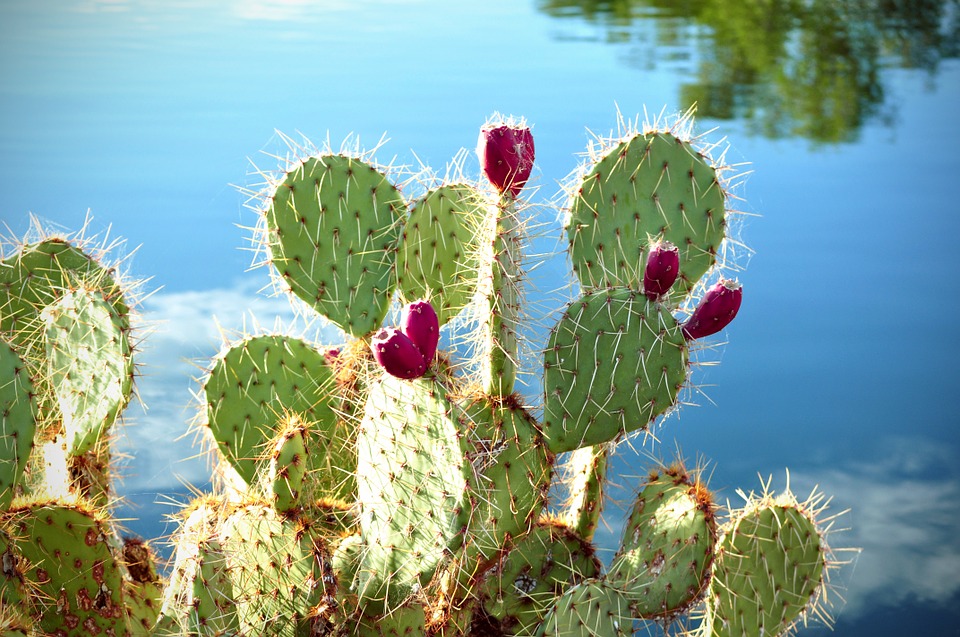Nature has provided different sources of life forms on which human survivedon planet Earth. Primitive man ate all types of fruits, leaves, roots of plants collecting from wild; before he learnt to grow plants. Out of the Earth’s half million plant species, only about 3,000 species havebeen used as agricultural crops and only 150 species are cultivated on largescale. Some edible plants and fruits are given below but If you are at any point unsure about the plant identification, we are advised not to consume it.
Prickly pear cactus
The Prickly Pear Cactus is a palatable as well as nutritious plant that is typically found in the dry area. Its fruit is red or purple in colour. It need very much precaution to remove spines present on the out skin of fruit. It is promoted for treating diabetes, high cholesterol, obesity and hangovers. It's also touted for its antiviral and anti-inflammatory properties.
Portulaca oleracea
This common 'weed' is native to India. Purslane can be found growing in cold climate areas as well as warm areas. It has been used in salads and as a medicinal plant (for people) for hundreds of years. Purslane is a good edible and is eaten throughout much of Europe and Asia.
Milk thistle
Milk thistle is a flowering plant that comes from the same family of plants as the daisy. It grows in Mediterranean countries and is used to make natural remedies. Although it can be used as food, milk thistle is better known as having medicinal benefits. Different parts of the milk thistle plant may be used to treat various health conditions. The most common use of milk thistle is for liver problems.
Mulberry
Succulent, refreshing, tart and sweet mulberries or shahtoot are seasonal beauties. They carry colorful berries most commonly black, white, or red. Due to their sweet flavor, impressive nutritional value, and various health benefits, mulberries are gaining popularity worldwide
Red Leaf Fig (Ficus congesta)
Ficus congesta is a smallish rainforest fig tree. The fruits of this Ficus species grow in clusters on the trunk as well as on the branches—another common name for this plant is cluster fig. New leaves are reddish in color when they unfurl.
Jamun/Syzygium cumini
Syzygium cumini is native to the Indian Subcontinent, known as black plum or jamun. The fruit tends to colour the tongue purple with its sweet, mildly sour flavor. This is a proven anti-ageing food, thanks to the multiple antioxidants it delivers. This fruit is very low on calories and is completely fat-free making it a perfect choice for those watching calories.
Curry berries
Curry berries are the fruit of the curry tree and grow in clusters consisting of 32-80 small fruits. Curry berries are round and approximately half an inch in diameter. The aromatic white blooms of the tree produce tiny fruits which start out green and ripen to a shiny black hue.
Ber – Just Berries
The ber (called bor in Marathi) is a tiny berry, pale yellow and reddish brown when ripe. Sometimes called the Indian jujube, they are commonly found from October-April. The high amounts of Vitamin C and Vitamin A in ber fruits make it a great anti-oxidant which also helps boost the immune system.
Common Fig (Ficus carica)
The fruit of the common fig is notably rich in vitamins and minerals, and many of these trees, especially some cultivars, are able to produce fruit even without pollination in a process called parthenocarpy.
Lasoda/ Lasura – Gum Berry
Lasura originates along the Himalayan tract up to 1,500 metres, with its natural habitat extending through the forests of India, Nepal and Myanmar. According to the book, “Indian Herbal Remedies,” the man regarded as the father of surgery in India, Sushutra, prescribed Cordia fruits as a coolant and astringent, to be used for biliousness, cough and internal haemorrhage.
Kokum – Indica Berry
Kokum tree grows in the western parts of India. The fruits are spherical with diameters of 2.5–5.0 cm. They are a reddish-purple in color and contain between 3 and 8 large black seeds containing 32–40% fat. It is is a rich anti-oxidant and is well-known as a famous summer drink.
Phalsa – Squash Berry
This really tiny, dark purple berry that beautifully balances sweet and sour flavours reminds everyone of blueberries. It is extremely rich in calcium, iron, magnesium, potassium, phosphorus and vitamin C and also contains anthocyanin flavonoids which are considered protection against cancer.
Dandelion
Dandelion are a family of flowering plants that grow in many parts of the world.They’re also known as Taraxacum spp., though Taraxacum officinale is the most common species. People use dandelion for conditions such as swelling (inflammation) of the tonsils (tonsillitis), infections of the kidney, bladder, or urethra (urinary tract infections or UTIs), and many others, but there is no good scientific evidence to support these uses.
Source: http://www.walkthroughindia.com/ https://www.thespruce.com/, http://theindianvegan.blogspot.com/, https://www.healthline.com/ https://matteroftrust.org/(2) (PDF) Wild Edible Fruit Plants of Eastern India. Available from: https://www.researchgate.net/publication/230875469_Wild_Edible_Fruit_Plants_of_Eastern_India [accessed Dec 09 2019]
